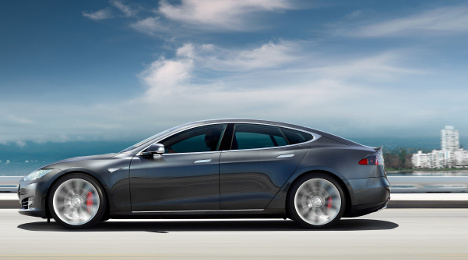Jumpstart Automotive Media discovered a 6-percent uptick in shopping for used cars across its portfolio of sites during the first quarter, which it attributes to a rise in shoppers looking for used luxury vehicles, in particular.
Used luxury shopping is up 11 percent year-over-year, while down 3 percent for new, according to Jumpstart’s latest quarterly report, titled Share of Shopper Interest Highlights.
Similarly, among non-luxury brands, shopping is up 4 percent for used cars and down 2 percent for new.
“This is one of the shifts we have expected to see as new cars sort of flatten from a retail and sales standpoint and also as the supply becomes greater on the used side,” Jumpstart marketing and strategic insights vice president Libby Murad-Patel said in a phone interview with Auto Remarketing.
“Between sales and from our audience standpoint, luxury is driving a lot of this activity.”
She said from a sales standpoint, a lot of the luxury brands are holding very strong right now.
According to Murad-Patel, the used market is growing because those shoppers interested in the technology of new vehicles and shoppers who want to try luxury for the first time often seek out used models.
“Why it particularly effects the used market is because used prices are starting to soften a little bit, and it’s a great way for someone to enter the luxury space for the first time,” Murad-Patel said.
“We definitely see that on the certified side or near-new vehicles in the 1- to 3-year-old age range, that is typically a nice entry point for a consumer who maybe doesn’t typically buy luxury, but wants test out those brands because you get such a good price discount. You’re getting a good product with low mileage, newer technology and high-end features,” she said.
Interestingly, Patel said the brands that are starting to see more interest from shoppers aren’t the biggest brands, such as Audi, Mercedes, and BMW, but some of the smaller luxury brands like Jaguar, Land Rover and Tesla.
“Certainly Tesla’s been in the news a ton, so they're seeing a lot of growth as well,” she added.
Additionally, Jumpstart’s latest quarterly report features the vehicle segments, makes, and models that captured the largest share of online auto shoppers during Q1.
The data reported represents the percentage share of online shoppers across Jumpstart’s portfolio that consists of more than 25 million in-market auto shoppers researching vehicles.
Black Book announced on Tuesday that it now powers the online trade appraisal resource for NsightLive, a content engagement company that works to deliver leads to dealers through its Live content platform that creates content experiences to increase customer engagement levels.
“With Black Book’s trade appraisal engine, NsightLive is filling the void for independent auto dealers who currently do not have a trusted trade appraisal tool that can be used online,” Black Book said in a news release. “Independent dealers can level the playing field leading to more successful sales transactions, especially since a more transparent valuation of a vehicle trade reduces friction between customer and dealer.”
At one independent auto dealership, Black Book said a recently completed Beta test showed online lead conversions jump by 50 percent.
"In today's world of online-first research when shopping for a vehicle, it's critical for dealers to provide the most accurate trade appraisal possible in order to build a stronger, more trusting relationship with the customer," Black Book senior vice president of sales Jared Kalfus said. "We're excited to partner with NsightLive and we believe their pioneering online content engagement platform will be a game changer for both independent and franchised dealers."
Aside from trade appraisals powered by Black Book, the platform showcases complete dealer inventory, available credit options and dealer reviews accessible to shoppers.
NsightLive also offers dealers a Hispanic certification program, whose offerings include credit, trade, dealer reviews, community events and dealer involvement within the local Hispanic community.
"We are excited to be a marketing partner with NsightLive and its content engagement platform because it helps level the playing field for independent dealers looking to attract more customers, build stronger relationships and sell more cars and trucks," said Paul John, executive director of the Georgia Independent Auto Dealer Association. "With Black Book powering NsightLive's online trade appraisal resource, customers will receive an accurate appraisal value on their trade in, which will increase efficiency of the transaction, give the buyer more control of the process, as well as give used car buyers the confidence to complete more purchase transactions with their local independent auto dealership."
Additionally, NsightLive offers social content integration for franchised dealers seeking to increase social engagement directly on their websites.
For more information on NsightLive's "Live" digital platform, visit www.NsightLive.com.
New York attorney general Eric Schneiderman reached settlements with 104 franchised and independent dealerships, according to an announcement released on Friday.
Empire State officials said vehicles were sold to New Yorkers without disclosing that the units were under recall for “dangerous unrepaired safety issues” such as unintended acceleration, airbag problems, vehicle fires, steering and brake loss and more.
New York’s top law enforcement official indicated the settlement also requires the dealers to provide consumers with advance notice of any existing and unrepaired recall, among other measures.
An investigation by the AG’s office identified dealers that advertised vehicles with unrepaired safety recalls, and officials monitored vehicles covered by safety recalls
As part of the settlements, the participating dealers are required to adhere to a set of guidelines in order to alert consumers that their vehicles may have unrepaired recalls, including the following:
• Dealers that advertise used vehicles online must include information that enables consumers to check the recall status of advertised vehicles; that information includes the SaferCar.gov website operated by National Highway Traffic Safety Administration.
• Dealers who advertise in print or other media must also disclose in the advertisement that the vehicle is subject to a safety recall.
• Dealers must place a decal notice in the window of used cars that include information that allows consumers to check the recall status of the vehicles, including the SaferCar.gov website and mobile application operated by NHTSA.
• Two days prior to any sale, dealers must provide consumers with a copy of the NHTSA recall status report for a vehicle with an unrepaired safety recall, and obtain a written acknowledgment from the consumer.
• Dealers must send notices to customers who have purchased vehicles with unrepaired safety recalls that are still unrepaired, from January 2016 to present. Manufacturers’ franchise dealers must also cover up to five days of a loaner car for consumers if their vehicle requires repairs that will take longer than one day.
Each dealer will also pay a fine of $1,000 to New York State.
“The safety recalls we uncovered were serious — and potentially deadly,” Schneiderman said. “Consumers deserve to know of any unresolved safety issues before buying a car for themselves or their family. I am pleased that thanks to our investigation and today's settlement, more New Yorkers will finally receive the critical safety information they need to make an informed decision.
“I encourage all auto dealerships across the state to follow our guidelines to ensure that they too uphold the highest standards of consumer safety. This is an important first step towards making all cars on New York’s roads safer,” he added.
The list of 104 dealerships is as follows, broken down by the AG regional offices that reached the settlements.
BINGHAMTON REGIONAL OFFICE – 15
1. Butler Auto Sales, Sidney
2. Chambers & O’Hara Truck Center, Sidney
3. North Norwich Motors & Trailer Sales, North Norwich
4. SHB Associates LLC (Serafini Nissan Volvo), Vestal
5. VanDervort Service Center, Vestal
6. Ridge Road Imports, Lansing
7. Milller Motor Car Corp., Vestal
8. Royal Ford, Royal Chrysler, Owego
9. Gault Auto Mall, Endicott
10. Gene Balmer’s Auto Sales, Elmira
11. Jeff Kies Auto Sales, Apalachin
BROOKLYN REGIONAL OFFICE – 2
1. Compass Luxor
2. Hamilton Avenue Auto Sales
BUFFALO REGIONAL OFFICE – 12
1. Basil Ford
2. SCGA Holdings, LLC DBA Castilone Chrysler Dodge Jeep & Ram
3. CrazyCheapCars
4. Northtown Automotive Companies
5. Landmark Chevrolet
6. Olean Class Cars
7. Ontario Sales
8. Pellegrino Auto Sales
9. Riverfront Auto Sales
10. Shults Management Group
11. Superior Auto Sales
12. V&A Enterprises, DBA Buffalo Auto Group
HARLEM REGIONAL OFFICE – 4
1. Best Auto Group, Bronx
2. Boston Road Best Motors, Bronx
3. New York Motors Group Solutions, Bronx
4. Manhattan Chrysler Jeep Dodge Ram, New York
NASSAU REGIONAL OFFICE – 1
1. LA Auto Sales
POUGHKEEPSIE REGIONAL OFFICE – 5
1. Hudson Valley Auto Sales
2. Ruge’s Automotive
3. Autos by Joseph
4. Frank Siena Auto Sales
ROCHESTER REGIONAL OFFICE – 16
1. Auction Direct USA
2. Best Value Auto
3. Cavallaro Neubauer Chevrolet Buick
4. Doan Buick
5. Doan Chevrolet
6. Doan Kia
7. Good Buy Auto
8. J & J Auto
9. Pioneer Truck Sales
10. Pool Auto Sales
11. Ralph Honda
12. Santa Motors
13. Stone Road Auto
14. Tiffany Transportation Services
15. Websmart Auto
16. Websmart Imports
SYRACUSE REGIONAL OFFICE – 25
1. Bill Rapp (2 Dealerships)
2. Bridgeland Auto Brokers
3. Cortland Used Cars
4. Liverpool World Car
5. Par-K Enterprises
6. TDK Property Company of Oneida,
7. TDK Property Co.
8. TRK-2 Operating Company
9. Tecforce Automotive, LLC
10. Drivers Village (13 Dealerships)
WATERTOWN REGIONAL OFFICE – (15)
1. FX Caprara Dealerships (14 Dealerships)
2. Waite Motor Sales
WESTCHESTER REGIONAL OFFICE (8)
1. JC Lopez Auto Sales, Port Chester
2. Croton Auto Park, Croton-on-Hudson
3. New Rochelle Chevrolet, New Rochelle
4. The Rivera Auto Group, Inc. d/b/a Rivera Toyota, Mt. Kisco
5. Rockland Motors, West Nyack
6. Rye Subaru, Rye
7. Saw Mill Auto Sales, Yonkers
8. Westchester Auto Exchange, Cortlandt Manor
Dominion Dealer Solutions announced on Thursday that Dominion Dealer Specialties has introduced LiveLot, a fully responsive video marketing platform that supplies auto dealers with full-service video marketing strategies and tools.
On the LiveLot mobile app, dealers can make and publish vehicle inventory videos with custom voiceovers, vehicle walkarounds and customer testimonials.
“In the past several years, the car buying process has transitioned from the brick and mortar showroom to the virtual showroom. In this more competitive environment, it is imperative that automobile dealers take full advantage of any opportunity to differentiate themselves from the competition and drive prospects to their physical locations,” Dominion inventory solutions general manager Shane Marcum said.
The new platform's dealer portal allows them to manage all of their video content in one location via a live dashboard that includes in-depth analytics for both consumer engagement and individual vehicles. Dealers can also build customizable landing pages for each of their videos.
“Our new feature-rich video offering, LiveLot, virtualizes the traditional selection and presentation steps of the 'road to the sale' and acts as an integrated part of the customer’s virtual showroom,” Dominion inventory solutions associate product manager Shelley Hoffman said. “By helping auto dealers with the shopping process, our video offerings drive prospects to the dealership lot who are engaged with the dealer’s sales team and ready to negotiate and close.”
Additionally, Dominion said each video is personally designed to maximize reach and enhance customer engagement.
For more information regarding LiveLot's offerings, visit www.drivedominion.com/livelot.
Consumers' increased interest in both trucks and SUV’s over sedans is a shift the industry will have to wrestle with even more this year, says John Rickel, senior vice president and chief financial officer of Group 1 Automotive.
“The overall industry, if you go back two years ago, had a 50/50 split between cars and trucks. Last year it got to 60/40 and this year could be 65/35 — that is a massive, massive shift in consumer preference,” Rickel said during Group 1’s presentation at the Bank of America Merrill Lynch 2017 Auto Summit in New York last week, a webcast of which Auto Remarketing viewed.
“Trucks and SUV’s are continuing to go from strength to strength. There’s a lot of customer demand there.”
He points to lower and affordable gas prices as the primary driver of the shift.
“If you can have the optionality of a bigger package — basically what a truck or SUV offers of you — most consumers are opting for that and the industry is struggling to catch up with that switch,” he said.
Used-car sourcing
During the presentation, Rickel said his group’s top source for used-cars are customers’ trade-ins.
“When we’re under pressure on the new vehicle sales, we’re not selling as many units — we’re not getting as many trades, and we have to go out to auction to supplement,” he said.
One downside, Rickel said, is that going to the auction to buy inventory can be more costly over time, after factoring in all of the added expenditures dealers incur.
“You’re going to pay a little bit more, you’re bidding against other dealers, you pay an auction fee and you’ve got transportation costs,” he said.
Residual trends in segments
In regards to sedans, within the used-car market in particular, there’s currently some pressure on residuals, according to Rickel.
“A lot of leases were written three years ago and that’s were a lot of volume is coming back,” he said. “We’re seeing a number of our OEM partners that have had to warn on residuals. You’re seeing them pull back somewhat on leasing.”
Rickel said he isn’t too strained about the residual values of trucks and SUVs.
Compared to sedans, trucks have a longer life and a number of consumers of have second order uses for them, he said.
In his 30 years of experience and the lease cycle he has seen, it has been rare that “you get a big, big falloff in truck residuals, so I’m less concerned about that,” Rickel said.
Specifically, if the rebound of the housing industry continues, he said it’s likely that construction workers use of trucks will increasingly secure their current standing in the market.
Rickel also added that if an infrastructure program comes from the Trump administration, it will presumably solidify truck sales as well.
Black Book’s latest recap of bidding activity and price movement showed how aggressively dealers are getting in the lanes either in person or online.
As certain units kept auction ringmen busy, the Black Book Market Insights report indicated 13 out of the total 22 vehicle segments saw an increase in average value.
On the other hand, editors found that the segment with the weakest retention was the sub-compact luxury crossover/SUV, which declined in value by 0.50 percent.
“Sentiment was positive in the auction lanes with most locations experiencing high sale percentages. This higher demand resulted in increased values in most segments last week,” said Anil Goyal, senior vice president of automotive valuation and analytics.
Before going into how dealers behaved, Black Book recapped its volume-weighted data, which showed overall car segment values increased by 0.10 percent last week. In comparison, the market showed similar performance increasing on average by 0.15 percent in the previous three weeks.
All car segments except luxury and premium showed an increase in values, according to editors, which pointed out that the sub-compact car and sporty car segments gained the most at 0.37 percent and 0.49 percent, respectively.
Again volume-weighted, Black Book determined overall truck segment values — including pickups, SUVs and vans — edged up slightly by just 0.05 percent last week. In comparison, editors mentioned truck values depreciated by 0.06 percent during the previous three weeks.
Black Book went on to mention minivan was the best performing segment, whereas sub-compact luxury crossover declined the most among truck segments.
And now those recaps from Black Book personnel stationed at about 60 auctions each week. The most colorful assessment came from North Carolina as the lane watcher reported back saying, “It is amazing how high dealers will bid to obtain the front-line ready inventory that they need. If it is a clean low-mile unit, look out.”
In New Jersey, a similar situation unfolded as Black Book’s representative said, “The auction this week was the best it has been in several months. Anything under $10,000 with curb appeal was especially strong.”
Next door in Pennsylvania, dealers walked the lanes or watched their screens. “Lots of people on the lanes and bidding online today. The dealer lanes I watched were experiencing very high sales percentages and the money was strong,” Black Book’s watcher in the Keystone State said.
Action was active down in Texas, too, with the recap mentioning, “Seemed like the lanes were much busier this week with a lot of strong sales.”
The last two reports Black Book shared came from Ohio and California, where the situation in the Buckeye State was, “Full-size trucks were selling very well with the bids closing out where they should. Average vehicles bringing average values.”
And out West, “Prices were up today. Most of the dealers I spoke with are short on cars for retail.”
Pre-owned Tesla Model S vehicles sell notably faster than some of its U.S. counterparts’ best-selling used models, according to Autolist.
The firm recently released a study that delved into used Tesla vehicles’ overall market performance relative to those of General Motors and Ford.
The pre-owned Model S averages 87 days on market, 5 percent below its peer group, reports the buyer intelligence firm’s study titled, Changing of the Guard: Tesla vs GM & Ford. That peer group includes the Audi A7, Porsche Panamera, BMW 6 Series, Mercedes-Benz CLS, and Lexus LS 460.
The top used models from GM and Ford — the Ford F-150, Chevrolet Silverado 1500, Chevrolet Malibu and Ford Fusion — spent between 88 days and 104 days on the market.
Additionally, the Model S also has higher pre-owned prices relative to expectations than top-performing GM and Ford vehicles.
Prices of the Model S have trended between 3 percent and 5 percent above expectations for the past year.
Meanwhile, prices for the top-performing used GM and Ford models have trended within 1 percent (above or below) expectations throughout the past year,
To compile this study, Autolist’s analysts took a look at more than 10 million vehicles from April 2016 to January.
“One thing important to understand about our study is — why we think its impactful — is because it’s a comparison relative to a peer group. And that’s a really important element of this analysis because if you’re just comparing raw numbers overall, you can control a cross segment,” Alex Klein, vice president of data science at Autolist, said in a phone interview with Auto Remarketing.
“But what this is really about is … Tesla’s performance relative to its competitors and Ford and GMs performance relative to its competitors. And when you think about things through that lens, that is really what drives brand perception, market value, investment financials, and so on and so forth.”
With the next Tesla model — the Model 3 — set to debut later this year, Klein said the brand's performance in coming years could be determined by the reception of this model, which would be its first mass-market vehicle.
“They have thus far just been a luxury market loyalty group,” he said. “And so when you introduce a mass-market vehicle at scale, there are a lot of potential benefits to getting more people involved with what is an incredible brand at a baseline level.”
According to a J.D. Power report released last month, drivers who purchase the brand’s lowest-price sedan are less likely to be comfortable with any technology-related snags.
Klein said, “Getting the Model 3 involved will get more people to engage with the Tesla brand and could potentially even further accelerate their performance relative to competitors as more car buyers are able to move from a traditional petroleum powered car to an electric vehicle.”
He said Tesla customers are likely to become interested in buying EVs over the long-term, which again has benefits for Tesla, but could also have benefits for other EVs on the market in the future, too.
“When you are buying a Tesla you are buying a next-generation automobile. There’s a perception that people are pushing the bounds of technology and they are being part of the forerunners of next-generation technology whenever they step foot in a Tesla,” Klein added.
More info on the study can be found here.
Car dealerships’ handling of leads outpaces other industries, according to Conversica, a provider of artificial intelligence driven lead engagement software for marketing and sales organizations.
Forty-nine percent of the dealerships in a Conversica study responded to leads within five minutes, which is the ideal window for qualification and conversion.
“Internet leads are an expensive resource, crucial to the success of automotive dealerships,” Alex Terry, chief executive officer of Conversica, said in a news release. “Our annual report offers a snapshot of how dealerships are handling leads today and how that behavior is changing over time. We compared real-world execution with best-practice research to help dealerships see where they’re performing well but also to pinpoint processes that need to improve.”
Conversica analysts examined nine industries and had secret shoppers visit a total of 538 companies, including 59 within the automotive industry.
In addition to the dealership lead response rate presented, the study found that only 6 percent took longer than 24 hours to respond and 25 percent made eight or more attempts to reply to queries.
“There are many things the auto industry is getting right,” Conversica said. “Automotive had by far the highest proportion of top-tier scores, with over one-third of respondents (38 percent) receiving an overall 'A' grade.”
The company said the report also shows that there is room for improvement.
Almost 20 percent of dealers did not respond at all to a direct sales inquiry from their website, according to the annual report.
“And 75 percent failed to make the eight or more attempts that research demonstrates are needed to engage an internet lead,” Conversica said.
Additionally, dealerships that are interested in being included in future reports can submit a request at http://www.conversica.com/4ps-assessment-request.
“There is an abundance of research on the importance of what Conversica describes as the Four Ps—promptness, personalization, persistence and performance—of successful lead engagement,” Conversica added.
“The goal of Conversica’s research was to determine the extent to which auto dealers are putting this information into practice.”
Seventy-four percent of the dealerships examined practiced the four key elements of personalization in their responses.
NextGear Capital announced recently that it has enhanced its website by adding more tools and resources that help dealers manage their vehicle and business needs.
NextGear said its site now delivers more convenient access to information. The newly enhanced site connects dealers to increased educational resources, lending products and auction sites that accept NextGear lines of credit, according to the company.
“With dealers’ ‘need for speed’ in mind, and in response to requests for easier access to information, we revamped our website to better meet their needs,” Shane O’Dell, president of Cox Automotive Financial Solutions, said in a news release. “We are always looking for ways to help our dealer clients grow their business and retain cash flow.”
The updated site offers two key new features that make it an easy-to-use resource hub, NextGear said.
It’s new Auction Finder tool allows dealers to quickly find auto auctions that take NextGear lines of credit. Auctions can be found locally or anywhere in the country just by entering a name and state or location into the search mechanism.
A new Dealer Resources tab offers access to Cox Automotive data and research, shopper insights, best practices, research and market reports, and more.
“The new tools on NextGear Capital’s website and app help us make quicker, better decisions,” Keith Yamanaka of Chicago Cars Direct said. “We have peace of mind about our choices knowing what vehicles are moving in the marketplace and the going rates.”
Additionally, its website now offers greater visibility of the company’s product offerings along with a rotating banner that displays any of its latest updates.
The American International Automobile Dealers Association reported that average length of time a new model sat on a dealer’s lot hit 70 days in March — the longest stretch of time since July 2009. Edmunds contends current new-vehicle inventory levels haven’t been this high since 2004.
Cox Automotive chief economist Tom Webb sees the assertions from AIADA and Edmunds stemming from franchised dealers starting both February and March with more than 4 million new units in stock as a headwind for both used- and new-vehicle sales.
Webb explained that hefty incentives were applied to that new-model inventory — a move that eventually places pressure on used-vehicle values — and the industry achieved a seasonally adjusted annual selling rate (SAAR) of 17.5 million in February. The strategy repeated in March, but the new-model SAAR fell to 16.5 million — the lowest reading since February 2015.
“Last month’s weak sales pace, plus less-than-needed production cuts, has left dealers with still too much new metal on the ground,” Webb said.
During his last quarterly conference call, Webb elaborated about where he thinks a healthy new-vehicle sales pace can be that leaves the used-vehicle segment with plenty of retail room to maneuver.
“I think if you look at it from a very long, long trend what you might term the underlying demand for new vehicles — the current vehicles in operation plus scrappage — I don’t think it’s that much north of 16 million going longer term. So the SAAR at some point has to move down below 17 million. But again it’s dependent upon what real retail demand there is out there,” Webb said.
“The fact that dealers have 4-plus million new vehicles in stock is the pressure on used-vehicle values. Obviously that’s too many,” he reiterated.
While used-vehicle production certainly can be attributed to situations such as trade-ins and off-lease returns, Webb acknowledged automakers have difficult challenges in managing factory production.
“A production adjustment has to be made with the sales pace in March being a disappointment,” Webb said. “We didn’t make a lot of the progress in terms of getting new-vehicle inventories in line. There’s still an overhang. To the extent the manufacturers produce to demand, then you don’t have that downward pressure on used-vehicle values. To a certain extent, I’m still hopeful that is what they will do.
“I’m somewhat surprised they’ve left their dealers holding that much inventory for such an extended period of time now rather than adjust,” he went on to say. “I know some of it has to do with imbalances and production schedules etc. But still, it is not a good thing for them since they also hold the residual values on 10 million leases out there.
“It’s not good for the manufacturers and it’s certainly not good for the dealers,” Webb added.
Update on rental-risk prices & volume
Manheim reported the average price for rental risk units sold at auction in March remained down 3 percent year-over-year. Webb explained prices were up relative to February, but less than the normal seasonal pattern would indicate.
Webb went on to note that a straight average of auction pricing for rental risk units in March represented a 3.5-percent rise from a year ago, “reflecting a better mix of market classes and lower mileage.” He added that SUVs and CUVs accounted for 33 percent of rental risk sales in March of this year versus only 25 percent last March. The share accounted for by compact cars fell from 29 percent to 25 percent.
Manheim also pointed out that average mileage for rental risk units in March (36,800 miles) decreased by 10 versus a year ago.
“Rental risk volumes sold at auction in the first quarter were up considerably, even compared to last year’s high level,” Webb said. “Unlike last year when dispositions were being driven by a high number of new units’ entering the fleet, this year’s off-rental volume was more the result of fleet rationalization. As such, off-rental auction volumes may weaken later in the year.”
Webb also touched on how the best of off-rental units aren’t necessary being skimmed off by rental car companies and being wholesaled other places than having those units come down the lanes.
“There was fear as the rental car companies used non-auction channels — direct to dealer sales and retail customers — that the auctions would end up with the higher mileage poor condition vehicles, the less desirable vehicles. But that has not been the case,” Webb said.
“I watch it very closely with the types of vehicles that come through our auctions and the condition levels. We’re not skewed in any way along those lines so that’s heartening,” he continued.
Meanwhile as those new-vehicle inventories pile up, Webb pointed out that OEMs aren’t falling back into previous practices by sending more units into the fleet space. Manheim determined that the combined rental, commercial fleet and government purchases of new vehicles decreased by 13 percent year-over-year in March, with the “all-important” rental segment down the most at a 14 percent decline.
“Granted, that was relative to a very high level a year ago,” Webb interjected.
“Certainly in the way past, basically when you had a lot of program cars, that was an avenue,” he continued. “Even when the manufacturers had ownerships in the rental car companies, you could use that as an avenue to keep factories open.
“Given the restructuring i.e. the bankruptcies that occurred during the recession, the manufacturers have a lot more flexibility in terms of production and in terms of making labor a more variable cost than a total fixed cost,” Webb went on to say. “To that extent, there’s less of a need to do that. Certainly they got burned in the past doing it. So to a large extent, most have not done that.”
And what about rental car companies working deals with the automakers?
“You look at the rental car companies and they’ll tell you they’re not getting that great of a deal in terms of the pricing,” Webb replied. “Certainly there’ll be a manufacturer of a particular model that will put a little pressure on the rental car company to take some of those units to even things out. But in the overall scene, they’re not overly pushing the market, which is a good thing.”












